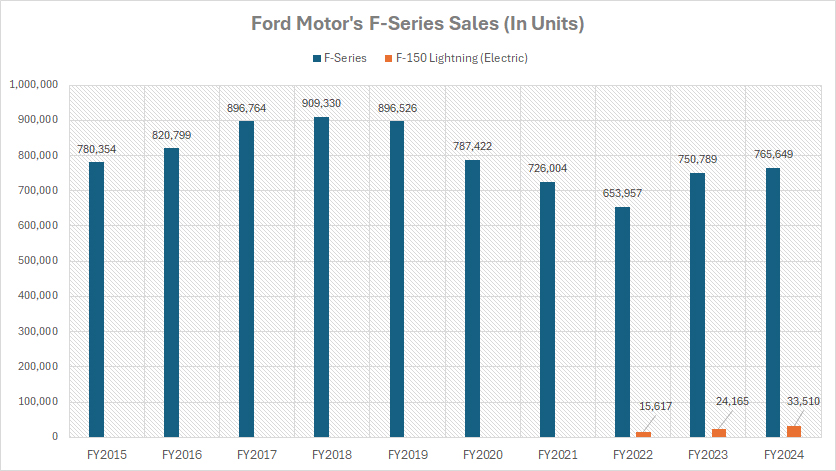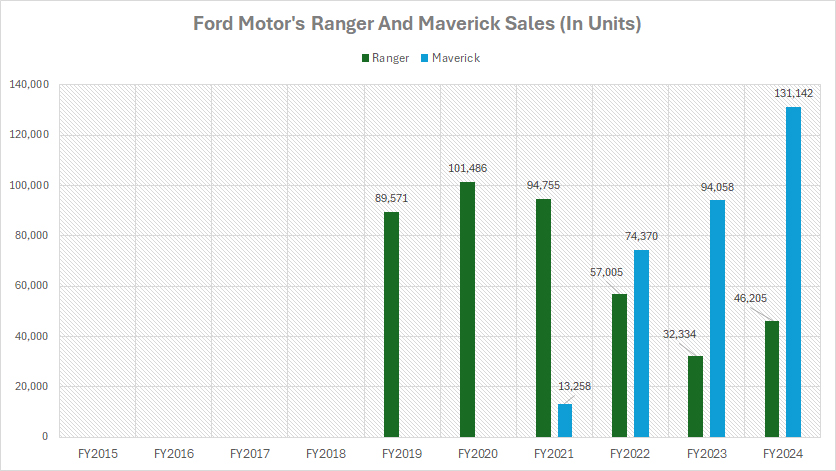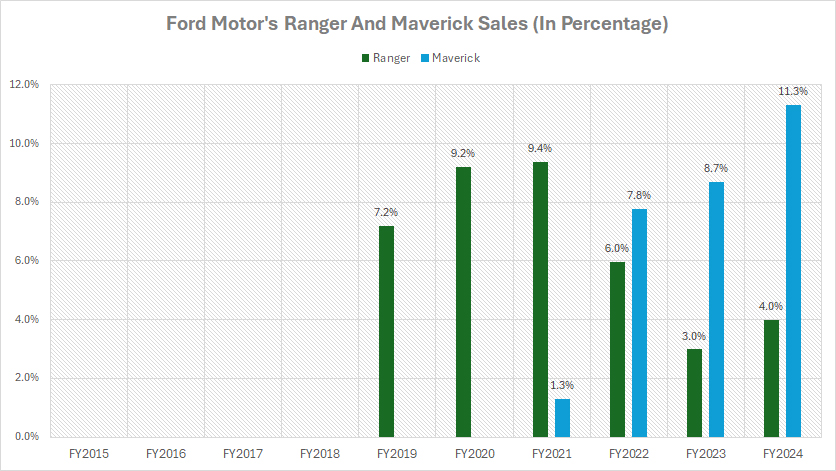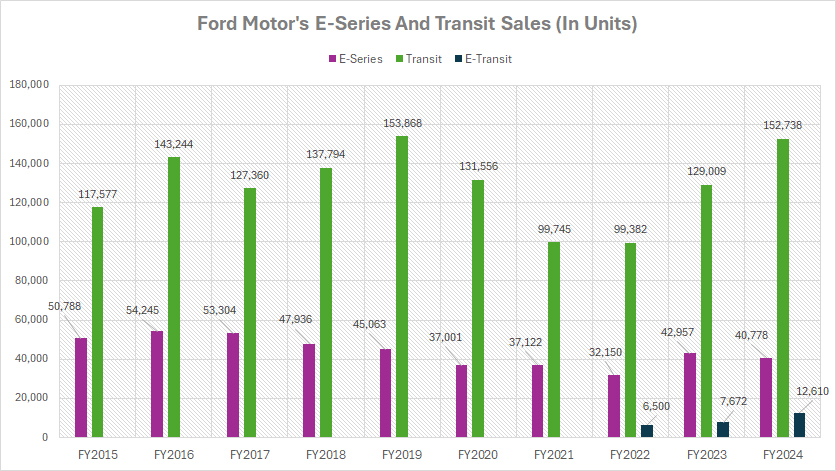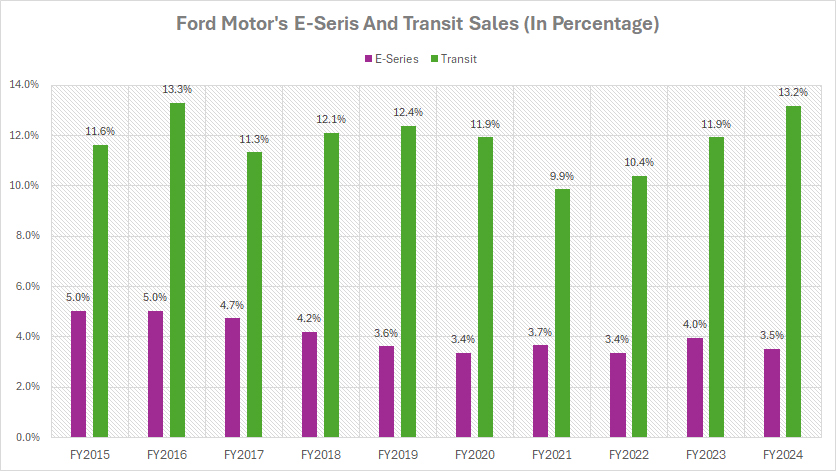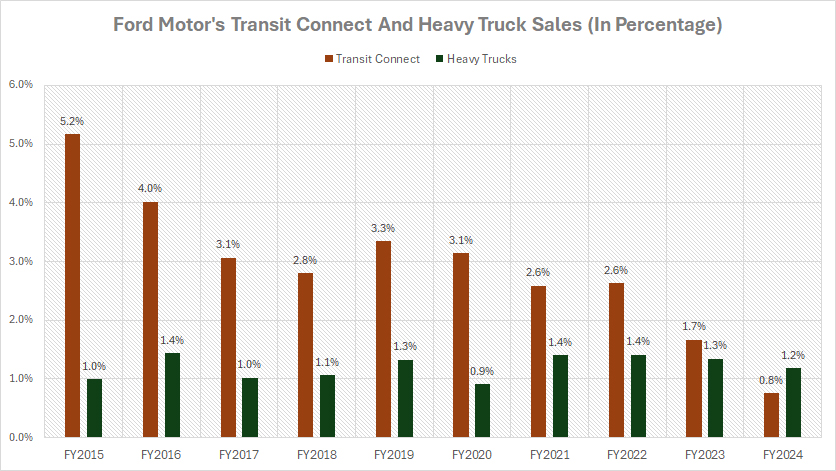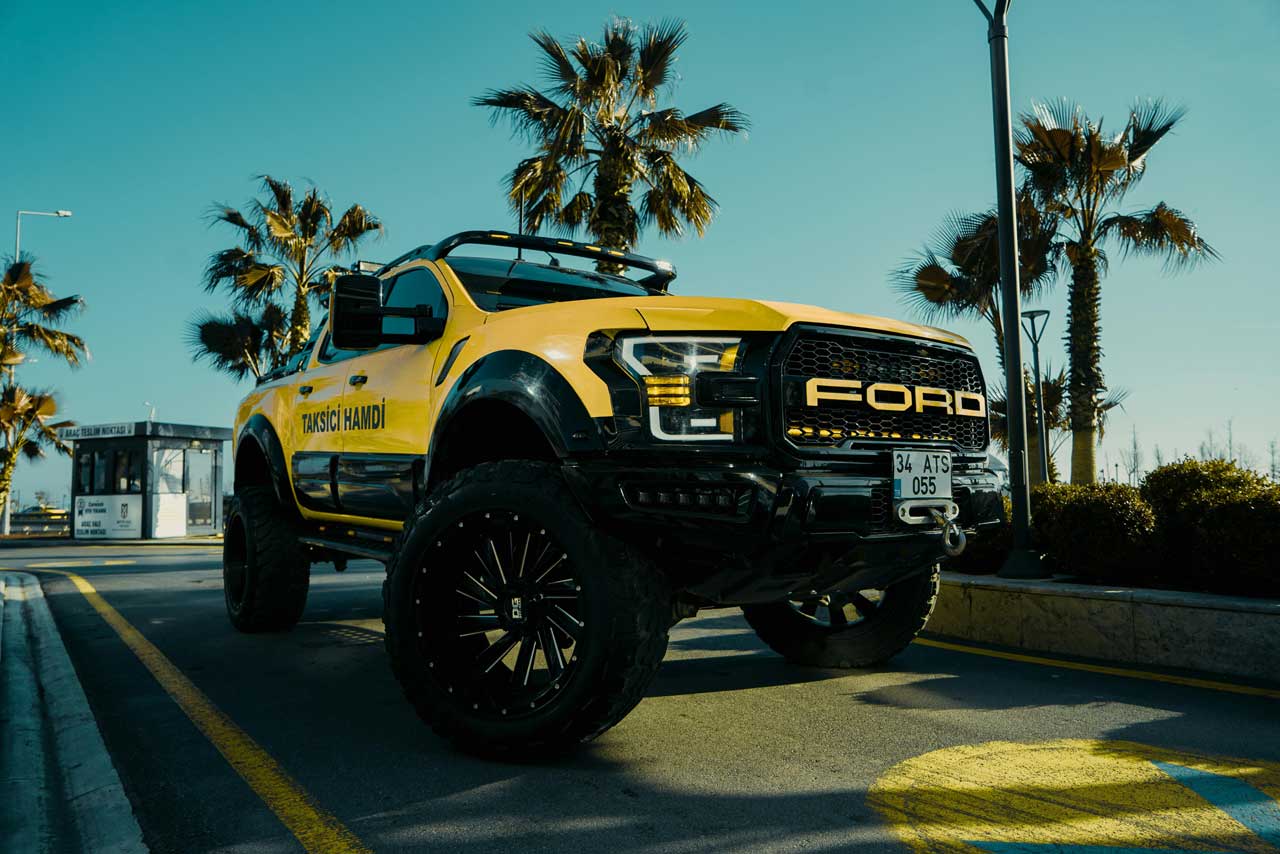
Ford truck. Pexels Image.
This article covers Ford Motor Company’s retail sales of trucks in the U.S. The sales results presented are exclusively for the U.S. market. Additionally, we focus solely on the retail sales results.
For other sales statistics of Ford Motor, you may find more information on these pages:
- Ford market share by country: America, China, Europe, etc.,
- Ford revenue streams: sales of new and used cars, services, and more, and
- Ford worldwide sales and market share.
Please use the table of contents to navigate this page.
Table Of Contents
Definitions And Overview
O2. How Are Vehicle Retail Volumes Measured?
Total Truck Sales
A1. Total Truck Sales In The U.S.
F-Series
B1. F-Series Sales
B2. F-Series Sales In Percentage
Ranger And Maverick
C1. Ranger And Maverick Sales
C2. Ranger And Maverick Sales In Percentage
E-Series And Transit
D1. E-Series And Transit Sales
D2. E-Series And Transit Sales In Percentage
Transit Connect And Heavy Trucks
E1. Transit Connect And Heavy Trucks Sales
E2. Transit Connect And Heavy Trucks Sales In Percentage
Conclusion And Reference
S1. Insight
S2. References and Credits
S3. Disclosure
Definitions
To help readers understand the content better, the following terms and glossaries have been provided.
Vehicle Retail Sales: Vehicle retail sales refer to the number of vehicles sold directly to consumers through retail channels, such as dealerships.
This metric typically includes sales of new and used cars, trucks, and other types of vehicles. Vehicle retail sales provide insight into consumer demand and purchasing behavior in the automotive market.
Key points to consider about vehicle retail sales:
- New vs. Used Vehicles: Retail sales can encompass both new and used vehicles sold to individual customers.
- Dealerships: The sales typically occur through authorized dealerships, which serve as the primary retail outlets for car manufacturers.
- Consumer Demand: Retail sales figures help gauge consumer demand and market trends within the automotive industry.
- Exclusions: These figures generally exclude fleet sales (e.g., sales to rental car companies, government agencies, and corporate fleets) and wholesale transactions.
Understanding vehicle retail sales is crucial for manufacturers, dealerships, and market analysts to assess the health and trends of the automotive market.
F-Series: Ford Motor’s F-Series trucks are a line of full-size pickup trucks that have been a cornerstone of the brand since their introduction in 1948. Known for their durability, versatility, and reliability, the F-Series trucks are widely regarded as one of Ford’s flagship products and a major contributor to the company’s global success.
The F-Series encompasses a range of models, from the workhorse F-150, which is a best-seller in the U.S., to the heavy-duty F-250, F-350, and beyond. These trucks cater to a diverse customer base, including individuals who need dependable vehicles for daily use, businesses that require rugged utility, and industries like construction and farming that demand exceptional towing and payload capacities.
The F-150 has become particularly iconic, with innovations such as lightweight aluminum alloy bodies, advanced towing technologies, and hybrid powertrain options. Additionally, Ford has introduced an all-electric variant, the F-150 Lightning, which represents their push into sustainable and cutting-edge automotive technology.
Ranger: Ford Motor’s Ranger trucks are midsize pickup trucks that offer a versatile and practical option for both personal and work use. Originally introduced in North America in the 1980s, the Ranger quickly became popular due to its manageable size, affordability, and durability. After a brief hiatus in the U.S. market, Ford reintroduced the Ranger in 2019, aligning its design and features with the needs of modern consumers.
Globally, the Ranger has been a strong player in Ford’s portfolio, particularly in markets like Europe, Asia, and Australia. It is renowned for its off-road capabilities, advanced technology features, and efficient engine options. In recent years, Ford has offered the Ranger with turbocharged engines and trims like the Ranger Raptor, which caters to enthusiasts seeking high-performance and rugged styling.
Ford’s Ranger trucks are highly competitive in the midsize truck segment, competing with models like Toyota’s Tacoma and Chevrolet’s Colorado. They provide a balance of utility, comfort, and innovation, appealing to drivers who need a reliable vehicle for both work and adventure.
Maverick: Ford Motor’s Maverick trucks are compact pickup trucks designed to be versatile, efficient, and affordable. Introduced in 2021, the Maverick marks Ford’s entry into the compact truck segment, offering a smaller and more accessible alternative to its larger models like the Ranger and F-Series.
The Maverick stands out for its standard hybrid powertrain, making it one of the most fuel-efficient pickup trucks available. It offers a balance of utility and practicality, with features like a “Flexbed” system for customizable cargo space, a payload capacity of up to 1,500 pounds, and a towing capacity of up to 4,000 pounds when equipped with the optional EcoBoost engine and towing package. Its unibody construction also provides a smoother ride and better handling compared to traditional body-on-frame trucks.
The Maverick is aimed at urban dwellers, young professionals, and first-time truck buyers who need a capable yet compact vehicle for daily use and light-duty tasks. It competes with models like the Hyundai Santa Cruz in the emerging compact truck market.
E-Series: Ford Motor’s E-Series vehicles, also known as Econoline or Club Wagon in earlier years, are full-size vans primarily designed for commercial and fleet purposes. Introduced in 1961, the E-Series became a staple for businesses, offering reliability and versatility for various applications like cargo transport, passenger shuttles, and even as the base for specialized vehicles like ambulances and recreational vehicles (RVs).
While no longer available as a passenger van in North America since 2014, the E-Series lives on as a trusted platform for cutaway vans and stripped chassis configurations. These models are widely used in industries such as delivery services, construction, and public transportation. Their robust engineering, high payload capacity, and adaptability make them a go-to choice for businesses needing dependable work vehicles.
Transit: Ford Motor’s Transit vehicles are versatile, full-size vans designed for both commercial and personal use. Introduced in Europe in 1965 and later expanded globally, the Transit series has become one of Ford’s most popular and widely used vehicle lines, particularly among businesses and fleet operators.
The Transit vans are known for their adaptability, offering a range of configurations including cargo vans, passenger vans, and chassis cab models. They cater to industries like logistics, construction, and transportation, providing features such as spacious interiors, customizable cargo space, and advanced technology options. The Transit is also equipped with modern safety systems and connectivity features, making it competitive in today’s market.
Ford has extended the Transit lineup to include innovative models like the Transit Custom and the all-electric E-Transit, reflecting the company’s push toward sustainability and electrification. The E-Transit is designed to meet the growing demand for eco-friendly commercial vehicles, offering zero-emissions operation without compromising on payload capacity or performance.
Transit Connect: Ford Motor’s Transit Connect is a compact van designed to cater to the needs of small businesses, urban delivery services, and individuals seeking a versatile vehicle for light-duty commercial and personal use. Originally introduced in Europe in 2002, the Transit Connect was later launched in North America and has since become a practical solution for those needing a smaller, more maneuverable alternative to full-size vans like the Ford Transit.
The Transit Connect is available in multiple configurations, including cargo vans and passenger wagons. It offers a compact footprint for better handling in tight urban spaces while still providing ample interior space for cargo or passengers. Features like sliding side doors, customizable cargo space, and efficient powertrain options make it an appealing choice for urban and suburban environments.
This vehicle also incorporates modern technology, such as driver-assistance systems and connectivity features, to enhance safety and convenience. It competes with models like the Ram ProMaster City and Nissan NV200 in the compact van segment.
Heavy Trucks: Ford Motor’s heavy trucks are designed for demanding commercial and industrial applications, offering robust performance, durability, and versatility. These trucks include models like the Ford F-650 and F-750, which are classified as medium-duty trucks and are widely used for tasks such as construction, delivery, and towing.
Ford also produces heavy-duty variants within its Super Duty lineup, such as the F-450 and F-550, which provide exceptional towing and payload capacities. Additionally, Ford’s global heavy truck offerings include the Ford Trucks F-MAX, a tractor-trailer model that has gained recognition for its advanced technology and powerful engine.
These trucks are built with features like high-strength steel frames, powerful diesel engines, and advanced safety systems to meet the rigorous demands of heavy-duty operations. They are popular among businesses and industries that require reliable and efficient vehicles for large-scale tasks.
How Are Vehicle Retail Volumes Measured?
Vehicle retail volumes in the U.S. are measured through a systematic process that involves tracking and analyzing the number of new vehicles sold to consumers through dealerships. Here are the key steps involved in measuring vehicle retail sales:
- Data Collection: Dealerships report their sales figures to automotive manufacturers and industry organizations. These reports include detailed information on the number of vehicles sold, categorized by model, make, and other relevant criteria.
- Centralized Reporting: The collected data is aggregated by automotive manufacturers and industry organizations such as the National Automobile Dealers Association (NADA) and the Automotive News Data Center. These organizations compile and maintain comprehensive sales databases.
- Seasonal Adjustment: Sales data is often adjusted for seasonal variations to provide a clearer and more accurate representation of underlying sales trends. This adjustment accounts for predictable fluctuations in sales that occur throughout the year.
- Monthly Reports: The adjusted sales figures are typically reported on a monthly basis. Key industry players such as the U.S. Bureau of Economic Analysis (BEA), Automotive News, and other industry publications release detailed monthly sales reports.
- Market Analysis: Analysts and researchers use the reported sales data to analyze market trends, consumer preferences, and the overall health of the automotive industry. This analysis helps identify patterns, forecast future sales, and make informed business decisions.
- Comparisons and Benchmarks: Sales data is often compared with historical data, competitor sales, and industry benchmarks to assess performance. This comparative analysis helps determine how well a particular brand or model is performing relative to others in the market.
By systematically collecting, reporting, and analyzing sales data, the U.S. automotive industry ensures that vehicle retail sales are accurately measured and understood.
Total Truck Sales In The U.S.
Ford-Motor-total-U.S.-truck-sales
(click image to expand)
The definition of Ford’s vehicle retail sales is available here: vehicle retail sales.
Ford’s total U.S. truck sales reached 1.16 million units in fiscal year 2024, an increase of 80,000 units from 1.08 million in 2023. This figure represents a strong recovery from the pandemic-era low of 955,500 units in 2022, which marked the lowest level ever recorded.
From fiscal year 2020 to 2022, Ford’s U.S. truck sales declined sharply due to the pandemic, hitting the lowest point in 2022. The subsequent rebound highlights a significant post-pandemic recovery in the U.S. truck market.
Looking at the past decade, Ford’s truck sales peaked at 1.24 million units in fiscal year 2019 but have been on a gradual decline since. Over the longer term, from 2015 to 2024, Ford’s truck sales in the U.S. have shown modest growth, increasing 15% from 1.01 million units to 1.16 million.
F-Series Sales
Ford-Motor-f-series-sales
(click image to expand)
The definition of Ford’s vehicle retail sales is available here: vehicle retail sales. You can find more information about Ford’s F-Series trucks here: F-Series.
Among Ford’s truck models, the F-Series has consistently been the company’s flagship and most successful product line. In fiscal year 2024, Ford sold 765,600 F-Series trucks in the U.S., reflecting an increase of 15,000 units compared to 750,800 sold in 2023. This steady year-over-year growth underscores the resilience and popularity of the F-Series despite shifting market dynamics.
The F-Series reached its lowest sales point of the last decade in fiscal year 2022, with only 654,000 units sold. This marked a significant drop, influenced by the challenges brought on by the pandemic, including supply chain disruptions and fluctuating consumer demand.
However, the series rebounded strongly, achieving a 17% increase in sales between 2022 and 2024, highlighting its enduring appeal and importance to Ford’s overall truck portfolio.
Over the longer term, from fiscal year 2015 to 2024, F-Series sales in the U.S. have exhibited relative stability, maintaining an average range around the 700,000 mark annually. The series peaked in fiscal year 2018, with sales surpassing 900,000 units — a figure that remains unmatched in subsequent years.
This high point reflects the strong market presence of the F-Series at its zenith. While sales have not returned to this level since, the F-Series remains a dominant force in the U.S. truck market and a vital contributor to Ford’s success.
The consistent performance of the F-Series demonstrates its ability to adapt to evolving customer needs, with innovative features such as hybrid powertrains and advanced towing technologies keeping it competitive. Its recovery and continued dominance affirm its position as a cornerstone of Ford’s brand identity.
F-Series Sales In Percentage
Ford-Motor-f-series-sales-in-percentage
(click image to expand)
The definition of Ford’s vehicle retail sales is available here: vehicle retail sales. You can find more information about Ford’s F-Series trucks here: F-Series.
From a perspective standpoint, in fiscal year 2024, Ford’s F-Series trucks accounted for 66% of the company’s total U.S. truck sales.
This share represents a significant decline from the peak of 80% in fiscal year 2018. Over the longer term, the F-Series’ contribution to total truck sales in the U.S. has dropped from 77% in 2015 to 66% in 2024, reflecting a notable 10-point decrease.
A notable trend is that, despite the absolute sales figures rising post-pandemic, the sales percentage has decreased, reflecting the significantly faster growth of other truck models.
Ranger And Maverick Sales
Ford-Motor-ranger-and-maverick-sales
(click image to expand)
The definition of Ford’s vehicle retail sales is available here: vehicle retail sales. You can find more information about Ford’s Ranger and Maverick trucks here: Ranger and Maverick.
Ford Motor reintroduced the Ranger truck series in the U.S. in fiscal year 2019, achieving sales of 90,000 units in the same year. Since then, the Ranger series has experienced a sharp decline, with sales dropping to 46,200 units in 2024 — a nearly 50% reduction from the 2019 figure.
In 2023, U.S. sales fell to 32,300 units, marking the lowest level since the reintroduction. However, the 2024 sales figures indicate a noticeable recovery for the Ranger series in the U.S. market.
Conversely, Ford’s Maverick truck series has demonstrated substantial growth. By 2024, sales climbed to 131,100 units, a significant increase from the 13,200 units sold in 2021 when the model was first introduced in the U.S. In 2023, Maverick sales reached 94,000 units, showcasing remarkable year-over-year growth and solidifying its place in the U.S. market.
Ranger And Maverick Sales In Percentage
Ford-Motor-ranger-and-maverick-sales-in-percentage
(click image to expand)
The definition of Ford’s vehicle retail sales is available here: vehicle retail sales. You can find more information about Ford’s Ranger and Maverick trucks here: Ranger and Maverick.
Ford Motor’s Maverisk sales accounted for just 4% of its total U.S. truck sales in fiscal year 2024, marking the lowest share since the model’s introduction in 2019. This figure represents a notable decline from the 9% contribution recorded in 2021.
In contrast, Ford’s Maverick series reached an 11% share of U.S. truck sales in fiscal year 2024, a significant rise from the 1.3% share it achieved in 2021 when it was first launched in the market.
E-Series And Transit Sales
Ford-Motor-e-series-and-transit-sales
(click image to expand)
The definition of Ford’s vehicle retail sales is available here: vehicle retail sales. You can find more information about Ford’s E-Series and Transit models here: E-Series and Transit.
Ford’s E-Series vehicles, designed primarily for commercial and fleet purposes, saw U.S. sales of 40,800 units in fiscal year 2024, a notable decline from the 50,800 units sold in 2015. After reaching a low point of 32,200 units in 2022 during the pandemic, the E-Series has shown modest recovery in subsequent years.
In contrast, Ford’s Transit model has achieved significant growth in the U.S. market. Fiscal year 2024 saw Transit sales rise to 152,700 units, a 19% increase from 129,000 units in 2023. During the pandemic, Transit sales dropped to 99,700 units in 2021 and 99,400 units in 2022. Since then, the Transit has experienced a strong post-pandemic recovery in the U.S. market.
E-Series And Transit Sales In Percentage
Ford-Motor-e-series-and-transit-sales-in-percentage
(click image to expand)
The definition of Ford’s vehicle retail sales is available here: vehicle retail sales. You can find more information about Ford’s E-Series and Transit models here: E-Series and Transit.
In fiscal year 2024, Ford’s E-Series vehicles accounted for 3.5% of total U.S. truck sales, a slight decrease from 4% in 2023. This is a notable decline from the 5% contribution recorded in 2015.
Ford’s Transit vehicles made up 13% of total U.S. truck sales in 2024, an increase from 12% in 2023 and a strong recovery from the 10% share in 2021. Pre-pandemic, in 2016, Transit vehicles represented over 13% of Ford’s total U.S. truck sales, the highest level observed.
Transit Connect And Heavy Trucks Sales
Ford-Motor-transit-connect-and-heavy-truck-sales
(click image to expand)
The definition of Ford’s vehicle retail sales is available here: vehicle retail sales. You can find more information about Ford’s Transit Connect and Heavy Truck models here: Transit Connect and Heavy Trucks.
Ford’s U.S. sales of Transit Connect vehicles have experienced a dramatic decline over the past decade. In fiscal year 2015, the retail volume of Transit Connect exceeded 52,000 units, reflecting its strong position in the compact van market at the time. By fiscal year 2024, sales had plummeted to just 8,800 units, representing an over 80% drop.
This sharp decline highlights the model’s waning relevance amidst changing market preferences and growing competition from other compact and versatile vehicles. Unlike other Ford truck models that have rebounded post-pandemic, the Transit Connect has struggled to regain its footing, underscoring its challenges in both demand and market positioning.
In contrast, Ford’s Heavy Trucks have shown consistent performance in the U.S. market over the past decade. In fiscal year 2024, sales totaled 13,700 units, a slight decrease from 14,600 units in 2023. Over the last ten years, Heavy Trucks sales have maintained a steady baseline, averaging at least 10,000 units annually.
This stability reflects the enduring demand for Ford’s heavy-duty offerings in specialized and industrial applications. The segment peaked at 16,500 units in fiscal year 2019 before experiencing fluctuations, likely influenced by industry cycles and external economic conditions.
Despite these variations, Ford’s Heavy Trucks continue to demonstrate resilience, remaining a vital component of its commercial vehicle lineup.
Transit Connect And Heavy Trucks Sales In Percentage
Ford-Motor-transit-connect-and-heavy-truck-sales-in-percentage
(click image to expand)
The definition of Ford’s vehicle retail sales is available here: vehicle retail sales. You can find more information about Ford’s Transit Connect and Heavy Truck models here: Transit Connect and Heavy Trucks.
Ford’s sales of the Transit Connect accounted for less than 1% of its total U.S. truck sales in fiscal year 2024, a steep decline from the 5% share achieved a decade ago in 2015. This sharp reduction highlights a dramatic loss in the model’s relevance within Ford’s truck lineup, reflecting both declining demand and competition in the compact van market.
The diminishing sales contribution of the Transit Connect underscores a significant challenge for this model, which has failed to regain traction post-pandemic.
In contrast, Ford’s Heavy Trucks contributed approximately 1.2% of the company’s total U.S. truck sales in 2024. This proportion has remained relatively stable over the past decade, demonstrating the steady performance and enduring demand for Ford’s Heavy Trucks within the commercial and industrial sectors.
Despite some fluctuations in absolute sales volumes, this consistency highlights the resilience and importance of Heavy Trucks in maintaining Ford’s foothold in the U.S. truck market, especially for specialized and heavy-duty applications.
Insight
Ford’s truck lineup reveals a story of resilience, strategic adaptation, and challenges. Models like the F-Series and Maverick highlight Ford’s ability to innovate and cater to evolving market demands, while the Transit exemplifies a strong recovery in commercial segments.
However, the significant declines seen in models like the Transit Connect and the Ranger point to potential gaps in addressing niche or competitive market segments. Sustaining long-term growth will likely require Ford to focus on diversifying its lineup and further leveraging innovation to reinforce its stronghold in both consumer and commercial markets.
References and Credits
1. All vehicle sales data presented in this article were obtained and referenced from Ford’s car sales reports published in the company’s investor relation page: Ford’s Car Sales Reports.
2. Pexels Images.
Disclosure
We may use artificial intelligence (AI) tools to assist us in writing some of the text in this article. However, the data is directly obtained from original sources and meticulously cross-checked by our editors multiple times to ensure its accuracy and reliability.
If you find the information in this article helpful, please consider sharing it on social media. Additionally, providing a link back to this article from any website can help us create more content like this in the future.
Thank you for your support and engagement! Your involvement helps us continue to provide high-quality, reliable content.
Thank you!


